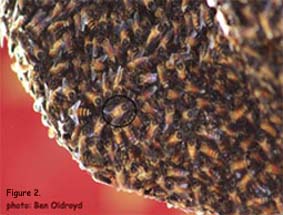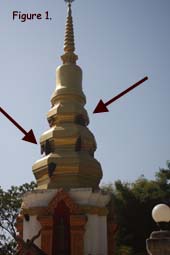 As I am sure every entomologist knows honeybees (genus Apis) communicate vectorial information about food sources to their nestmates via the dance language. Despite the dance language’s fame, several studies have recently shown that its use doesn’t increase a colony’s foraging efficiency under all circumstances (Beekman & Lew 2008; Dornhaus & Chittka 2004; Sherman & Visscher 2002). The dance seems most beneficial when forage is locally abundant and individual discovery rates are low. Yet, returning foragers spend a lot of time dancing, and unemployed bees do their best to extract the information from the dance. The current paradigm states that the dance language was important during the evolution of the genus Apis as it allowed the bees to quickly exploit locally abundant food sources and to keep track of changing conditions in their foraging environment. Thus, even if the dance language doesn’t benefit the bees that much now, it provided them with the opportunity to outcompete other flower visitors when the genus Apis was still restricted to its natural habitat. But if the bees’ foraging conditions selected for the ability to communicate the location of ephemeral food sources, why didn’t the other class of social bees, the stingless bees (Meliponini), evolve a similar communication mechanism? After all, both honeybees and stingless bees are thought to have evolved in the same environment.
As I am sure every entomologist knows honeybees (genus Apis) communicate vectorial information about food sources to their nestmates via the dance language. Despite the dance language’s fame, several studies have recently shown that its use doesn’t increase a colony’s foraging efficiency under all circumstances (Beekman & Lew 2008; Dornhaus & Chittka 2004; Sherman & Visscher 2002). The dance seems most beneficial when forage is locally abundant and individual discovery rates are low. Yet, returning foragers spend a lot of time dancing, and unemployed bees do their best to extract the information from the dance. The current paradigm states that the dance language was important during the evolution of the genus Apis as it allowed the bees to quickly exploit locally abundant food sources and to keep track of changing conditions in their foraging environment. Thus, even if the dance language doesn’t benefit the bees that much now, it provided them with the opportunity to outcompete other flower visitors when the genus Apis was still restricted to its natural habitat. But if the bees’ foraging conditions selected for the ability to communicate the location of ephemeral food sources, why didn’t the other class of social bees, the stingless bees (Meliponini), evolve a similar communication mechanism? After all, both honeybees and stingless bees are thought to have evolved in the same environment.
A few years ago I came up with the idea that perhaps the bees’ dance language is not an adaptation to exploit food sources but evolved for the purpose of nest site selection (Beekman et al. 2008; Beekman & Lew 2008). The bees use the same dance language to transfer vectorial information about potential nest sites (Lindauer 1955). While in both groups a colony reproduces by swarming, the stingless bees move to their new site gradually, slowly moving resources until a queen and her workers have moved in. And even then, the old and new nest remain connected, at least for some time. In contrast Apis bees decide on a new site prior to the whole swarm moving in. Which site to choose out of a large number of suitable sites, is decided using the dance language.
If the dance language indeed evolved for the purpose of nest site selection, we would expect that Apis species that differ in their nesting requirements differ in the way they use the dance language when selecting a new home. Whereas some species nest in cavities, others build a single comb in the open around a twig or a branch or under an overhang. It is conceivable that suitable cavities are much harder to locate. Finding a shaded twig on the other hand, the preferred nest site of the dwarf honeybees, seems much easier.
James Makinson is currently in his second year of his PhD studying nest site selection in Asian honeybees. James already found that the nest site selection process of the dwarf bee A. florea is rather different to that of the better studied cavity nesting A. mellifera (the only Apis species present in Australia, although originally from African and Europe). In contrast to A. mellifera, which carefully selects the best site possible prior to taking off, A. florea seems content with locating a general area containing many trees; the actual nest site is then decided on the wing. These differences in nest site requirements are reflected in the way the two species use the dance language. The dance of A. mellifera provides precise vectorial information, whereas the dances of A. florea workers can be described as ‘sloppy’, mainly indicating a large area (Makinson et al. 2010).
It is tempting to take these results as evidence for the original hypothesis that the dance language evolved to communicate the location of new nest sites and was later co-opted to locate profitable forage. But we need to be careful, as we only have data on two species at the extreme end of the spectrum. James is currently spending 6 months in Chiang Rai, Thailand, on an Endeavour Fellowship to continue his investigation into the nest site selection process of Asian Apis species. Together with Ben Oldroyd (The University of Sydney), local PhD student Atsalek Klakasikorn we just managed to find a way to study nest site selection in the giant honeybee Apis dorsata. A. dorsata prefers to nest in aggregations, in tall ‘bee trees’ or on buildings. Hence, it appears that its’ nest site requirements are intermediate between that of the cavity nesting A. mellifera and the dwarf honeybee A. florea. I thus look forward to hear what James’ results will show us.
Beekman, M., Gloag, R. S., Even, N., Wattanachaiyingcharoen, W. & Oldroyd, B. P. 2008 Dance precision of Apis florea - clues to the evolution of the honey bee dance language? Behavioral Ecology and Sociobiology 62, 1259-1265.
Beekman, M. & Lew, J. B. 2008 Foraging in honeybees - when does it pay to dance? Behavioral Ecology 19, 255-262.
Dornhaus, A. & Chittka, L. 2004 Why do honey bees dance? Behavioral Ecology and Sociobiology 55, 395-401.
Lindauer, M. 1955 Schwarmbienen auf Wohnungssuche. Zeitschrift für vergleichende Physiologie 37, 263-324.
Makinson, J. C., Oldroyd, B. P., Wattanachaiyingchareon, W. & Beekman, M. 2010 Moving home: nest site selection in the Red Dwarf honeybee (Apis florea). Behavioral Ecology and Sociobiology 10.1007/s00265-010-1095-9.
Sherman, G. & Visscher, P. K. 2002 Honeybee colonies achieve fitness through dancing. Nature 419, 920-922.


Figure 1: An aggregation of the giant honeybee Apis dorsata on a pagoda in northern Thailand (photo: Ben Oldroyd).
Figure 2: A dancing A. dorsata worker (encircled). The dancer is closely followed by other bees attempting to decode the dance (photo: Ben Oldroyd).



